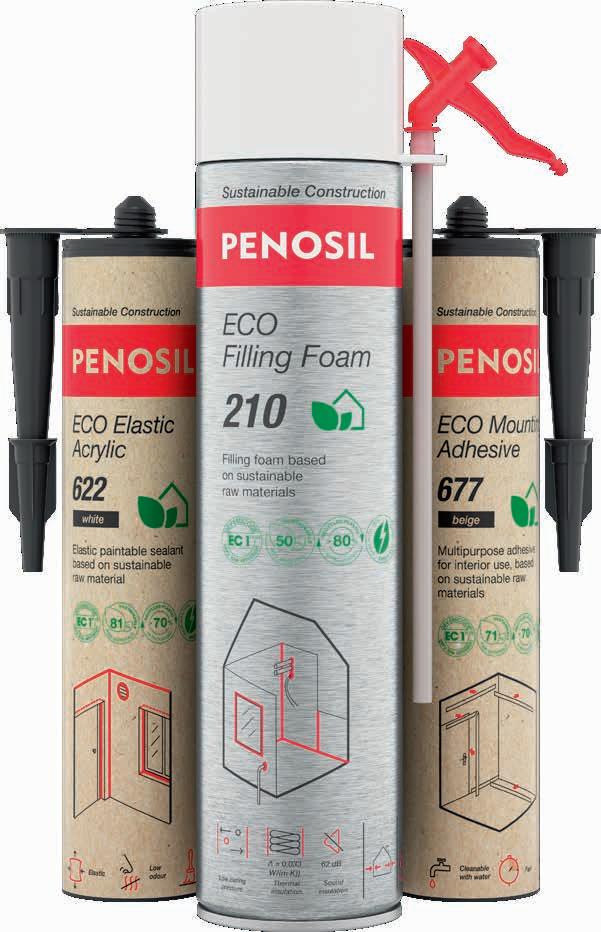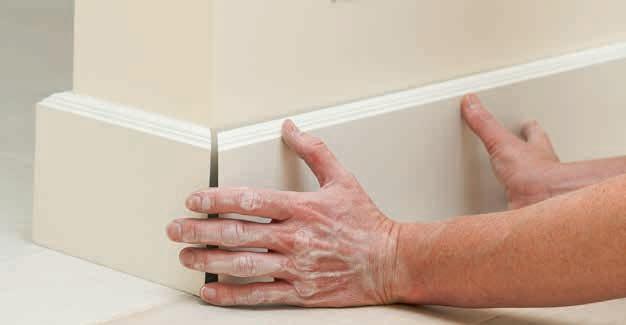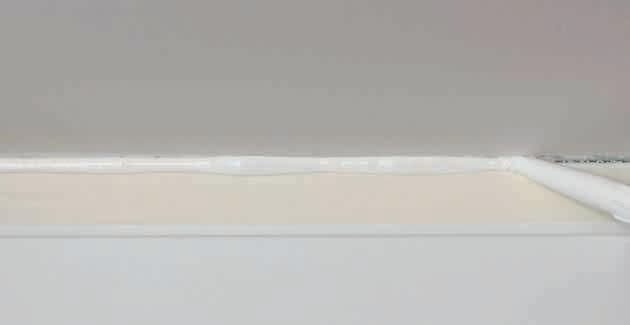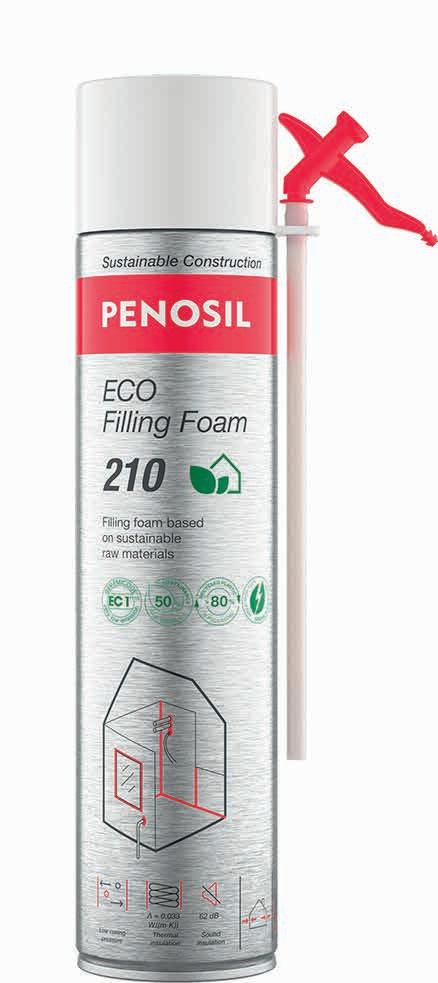Sustainable Construction


PENOSIL ECO line is an innovative line of sustainable and healthier products for people who care about the environment and the future of our planet.

For this range, we use sustainable raw materials and sustainable packages produced from recycled or biobased resources to reduce environmental footprint of the product production process.

Sustainable Construction
PENOSIL ECO line products are gathered under Sustainable Construction category and are truly unique in three aspect:
■ The formulas are in large part (50-81%, depending on product) made from sustainable raw materials using the latest technologies in the field.
■ The packages are the most sustainable available in the market, made of PCR (post consumer recycled) plastic and metal can produced with three times lower CO2 than regular.
■ Genuinely ecological products have same time superb product features, sustainability has been achieved without any compromising on product properties. On the contrary, they offer the best user experience.
Penosil Sustainable Construction category consists of three products:

■ ECO Mounting Adhesive 677 – multipurpose adhesive for interior use.
■ ECO Elastic Acrylic 622 – elastic paintable sealant for interior and exterior use.

■ ECO Filling Foam 210 – multipurpose PU foam with straw applicator and low curing pressure.

ECO AdhesiveMounting 677
Multipurpose adhesive for interior use

Solvent free
Good initial grab
Adheres well to most construction and finishing materials


■ Can be painted with water-based paints
■ Cleanable with water
■ UV and moisture proof
Installation of wood and plasterboard panels, reinforcement of screw joints and reducing of the number of screws needed. Upon finishing works, for the installation of door and floor mouldings and various decorative details. For quick repair jobs.
EC1Plus certified.
71% of the ingredients are based on biobased materials or materials produced with lower ecological footprint.
Recycled plastic content in packaging is >70%.
Produced with 100% green electricity.
290 ml, cartridge Colour
Fast Cleanable with water Low odour Sustainable Construction
ADHESIVE: Tips and tricks
Best results:
■ Make sure surfaces are clean, dry and free from any dust, loose particles, water, grease and oil stains.
■ Non-porous surfaces should be cleaned with solvent and a clean, non-fluffy cotton cloth. Solvent excess should be removed with a clean cloth.
■ Ensure sufficient ventilation in the working area, so the adhesive can dry.
Which glue patterns to use:
■ When installing skirting board in the corners use a straight-line pattern.





■ Dotted or zigzag pattern can also be used.
How to use:


■ Cut the tip of the cartridge.
■ Screw on the nozzle and cut an opening.
■ Place the cartridge into application gun.
■ Apply the adhesive by keeping an even pressure on the gun trigger and smoothly dragging the nozzle along the surface.
■ Immediately press the surfaces together and apply pressure or support until the product is fully cured.
■ Clean the adjacent surfaces, tools and hands with water or Penosil Cleaning Wipes 941.
ECO Elastic Acrylic 622


Elastic paintable sealant for interior and exterior use

Solvent and phtalate free, low odour
Remains elastic
Excellent for movable jonts
Safe to use on various surfaces
■ Bright white
■ Cleanable with water
■ Long-lasting, durable, weather-resistant
■ Easy to apply, dries quickly
Excellent for applications where regular acrylic may fail.
Joints between window and wall
Inner wall corners.
Joints between door frame and wall. Important! Early painting may cause cracking of the paint.
EC1Plus certified.
81% of the ingredients are based on biobased materials or materials produced with lower ecological footprint.
Recycled plastic content in packaging is >70%.
Produced with 100% green electricity.
EN 15651-1:2012: F-INT-EXT-CC: CLASS 12,5E
300 ml, cartridge Colour
Low odour Paintable Elastic Sustainable Construction
ACRYLIC: Tips and trick
Best results:
■ Make sure surfaces are clean, dry and free from any dust, loose particles and oil stains.

■ Use a vacuum cleaner to clean the deeper joints.
■ Cover the adjacent surfaces with masking tape to ensure crisp and clean joint edges.

■ During the curing process, make sure that sealed surfaces stay clean and are not under mechanical stress.
■ Do not paint over the sealant until it is fully cured, otherwise the paint might crack.


■ For best finishing, use appropriate smoothing tool.
Cleaning:
■ Cut the tip of the cartridge.
■ Screw on the nozzle and cut an opening at a 45° angle which is slightly larger than the joint to be sealed.
■ Place the cartridge into a sealant gun.
■ Apply the sealant by keeping an even pressure at the gun trigger and smoothly dragging the nozzle along the joint.
■ Spray some soap water mixture on the sealant, remove the excess sealant and smooth the surface with a spatula.
■ Remove the tape immediately after application and clean the adjacent surfaces, tools and hands with water or Penosil Cleaning Wipes 941.
ECO Filling Foam 210


Multipurpose PU-foam with low curing pressure
Good filling properties
Strong and solid structure
Excellent air tightness, thermal and sound insulating properties
■ Can be plastered and painted

■ Good dimensional stability
Filling of holes and gaps. Insulation of penetrations. Sealing window and door joints. Reducing the impact of thermal bridges. Thermal and sound insulation.
M1 and EC1Plus certified.
50% of the ingredients are based on biobased materials or materials produced with lower ecological footprint.
Recycled plastic content in packaging is >80%.
Bluemint steel foam can, with 67% reduced specific CO2 emissions.
Produced with 100% green electricity.
600 ml in aerosol can Colour
Sound insulation Thermal insulation λ = 0,033 W/(m·K) 62 dB Low curing pressure Sustainable Construction
FOAM: Tips and tricks
Best results:
■ Make sure the working area is clean from dust, loose particles and oil stains.
■ Most PU foam need humidity to expand and cure. Spray some water mist on the surfaces to help the foam expand and cure faster.
■ Careful! You want to dampen the surface, not wet it.
■ Wipe the surface with cloth if it’s too wet.


■ You can also mist the foam afterwards to maximise expansion and speed up the curing process.
■ In case of larger joints, apply foam in several layers and moisten slightly between each layer.
■ Check on the foam can label how much the foam expands. Do not overfill the joints.
■ Excess foam can be cut after it has fully cured.
■ Cured foam needs to be covered with an opaque material to protect against UV rays.
■ Do not cut or cover the foam before it has fully cured, or its properties will be ruined.
Cleaning:
■ Foam is quite sticky. Protect the surfaces around with tape or paper.

■ Lay down cardboard or paper to protect the floor.
■ Have a box or piece of cardboard ready where to set down used foam can (it can drip).

■ Uncured foam on tools and surfaces can be cleaned with Penosil Foam Cleaner 949 or acetone.
■ Uncured foam on hands and clothes can be cleaned with Penosil Cleaning Wipes 941
■ Cured foam can be first softened with Penosil Foam Remover 972 and then scraped with a tool.

■ Always use protective glasses and gloves when working with foam.
How to use:
■ Shake the can at least 20 times.
■ Hold the foam can in an upright position with valve up.
■ Screw the straw applicator tightly to the can valve.
■ Hold the can upside down when extruding the foam.
■ Foam output can be adjusted with the adjustment screw.
■ Extrude some of the initial foam (1-2 sec) to a bin bag to get rid of air bubbles.
Sustainable Construction
Q&A
What makes the raw material sustainable?
How do we calculate the percentage of sustainable raw materials compared to regular products?
In addition to the usual range of chemicals, the formulas of the ECO products contain various components, the synthesis of which many has different possibilities for the use of renewable or recycled raw materials, as well as for the use of waste. The following options are implemented in the manufacture of some of the main chemicals:
■ Use of pre-consumer recycled materials
■ Plant-based feedstock (instead of crude oil)
■ Mass-balance approach – certified consumption of bio-waste and residues in the chemical production process
The overall content of sustainable materials for specific formula consists of relative shares of recycled/renewable/waste material quantities in used raw materials.
This booklet is printed on 100% recycled fiber uncoated paper.




General Construction Window & Door Roof & Facade Floor Sanitary Decoration Fireproofing / High Temperature Adhering Cleaning Wolf Group Suur-Paala 10 13619 Tallinn Our other categories are: penosil.com






















